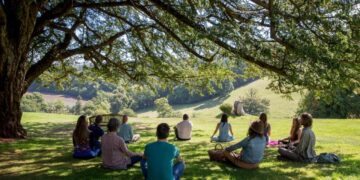Life is an intricate tapestry woven with daily routines, responsibilities, and familiar comforts. Yet, beyond this predictable landscape lies a world of untold experiences, personal growth, and profound discovery—a world of journeys waiting to be claimed. This extensive guide will empower you to recognize, plan, and embark on your own unique adventure, moving beyond the ordinary to embrace the extraordinary. We’ll explore the multifaceted nature of journeys, from physical expeditions to internal quests, providing actionable insights to help you not just travel, but truly transform.
The Irresistible Call of the Journey

What is it about the concept of a “journey” that resonates so deeply within the human spirit? It’s more than just a desire for novelty; it’s a fundamental human urge for growth, meaning, and connection.
A. Breaking the Chains of Routine: Our daily lives, while offering stability, can sometimes feel monotonous. A journey offers a powerful antidote, a chance to step outside the predictable, disrupt patterns, and inject fresh energy and perspective into our existence. It’s an opportunity to hit the reset button.
B. Catalyst for Personal Evolution: Journeys, by their very nature, push us out of our comfort zones. They demand adaptability, resilience, and problem-solving skills that we might not even realize we possess. These challenges are the fertile ground for personal growth, revealing hidden strengths and fostering a deeper understanding of ourselves. Many find their most significant personal breakthroughs occur during or after a challenging journey.
C. Forging Unforgettable Memories: While everyday life tends to blur, the vivid experiences of a journey often stand out in sharp relief. The breathtaking vistas, unexpected encounters, moments of triumph, and even moments of struggle become etched into our memory, forming a rich reservoir of stories and reflections that enrich our lives for years to come.
D. Broadening Horizons and Worldview: Engaging with new cultures, landscapes, and perspectives fundamentally shifts our understanding of the world. It cultivates empathy, challenges preconceived notions, and fosters a more nuanced appreciation for the diversity of human experience. This expansion of our worldview is invaluable.
E. Reigniting Passion and Purpose: When life feels stagnant or directionless, a journey can be a powerful catalyst for reigniting passion. Whether it’s pursuing a long-held dream, learning a new skill, or dedicating time to a cause, the focused pursuit of a journey can bring immense clarity and a renewed sense of purpose.
Diverse Paths to Discovery
Journeys are not one-size-fits-all. They come in countless forms, each tailored to different aspirations and temperaments. Recognizing the various types can help you identify the path that truly calls to you.
A. The Grand Expedition: Global Wanderlust: These are often the most romanticized journeys, involving extensive travel.
1. Cultural Immersion Adventures: Delving deep into the heart of a foreign culture. This means more than just sightseeing; it involves living with locals, participating in daily life, learning a language, or engaging in traditional crafts. Think months backpacking through Southeast Asia, studying art history in Italy, or volunteering with a community project in South America.
2. Wilderness and Nature Quests: Exploring the raw beauty and untamed power of the natural world. This could be multi-day treks through mountain ranges, wildlife safaris, deep-sea diving expeditions, or challenging climbs. These journeys test physical limits and foster a profound connection with the environment.
3. Historical and Ancestral Traces: Following the footsteps of history or lineage. This involves visiting ancient ruins, battlefields, ancestral homelands, or pilgrimage routes that hold deep personal or historical significance. It’s a journey of connection to the past.
B. The Intellectual Odyssey: Journeys of the Mind: Not all journeys require a passport. Many take place entirely within the realm of thought and knowledge.
1. Mastery of a New Skill: Committing to the rigorous process of becoming proficient or expert in a completely new area, whether it’s coding, playing a musical instrument, learning a complex craft, or mastering a new language. The journey lies in the disciplined practice and intellectual challenge.
2. Deep Dive into a Subject: Undertaking extensive research, reading, and critical thinking to become truly knowledgeable about a particular academic field, scientific discipline, or obscure historical topic. This is a quest for profound understanding.
3. Creative Project Endeavors: Embarking on a significant creative undertaking, such as writing a novel, composing an album, designing a complex artistic piece, or developing a groundbreaking invention. This journey is about imagination, perseverance, and bringing something new into existence.
C. The Inner Passage: Emotional and Spiritual Quests: These are often the most challenging, yet most rewarding, journeys, taking place within ourselves.
1. Healing and Recovery Journeys: Overcoming personal adversity, trauma, grief, or addiction. This often involves therapy, introspection, self-compassion, and a dedicated effort towards emotional well-being. It’s a brave and transformative path.
2. Self-Discovery and Identity Exploration: Delving into one’s core values, beliefs, passions, and purpose in life. This could be triggered by major life changes or a conscious decision to understand oneself more deeply, leading to significant shifts in personal identity.
3. Spiritual Awakening and Contemplation: A quest for deeper meaning, connection to a higher power or universal consciousness, or a profound sense of inner peace. This might involve meditation retreats, philosophical study, or silent contemplation in nature.
D. The Community Contribution: Journeys of Service: These journeys are focused on giving back and making a tangible difference.
1. Volunteering Abroad: Spending time in another country contributing to local communities, conservation efforts, or social programs. This combines travel with purpose.
2. Local Community Engagement: Deeply involving oneself in local causes, initiatives, or social projects within one’s own town or city. This journey is about impact close to home.
3. Advocacy and Activism: Dedicating oneself to a cause, campaigning for change, or working towards social justice. This is a journey of conviction and persistent effort.
Crafting Your Journey

Once you’ve identified the type of journey that resonates with you, meticulous planning transforms aspiration into reality. This phase is about laying a solid foundation for success.
A. Defining Your “Why” and Specific Goals: Before anything else, clarify your motivation. Why do you want to undertake this journey? What specific outcomes or transformations do you hope for? Whether it’s to summit a peak, learn a new language, or overcome a personal challenge, clear goals provide direction and motivation.
B. Thorough Research is Non-Negotiable: Knowledge empowers your journey.
1. Destination Specifics (for travel): Dive into climate patterns, cultural nuances, local customs, political stability, safety concerns, required vaccinations, and visa requirements. Utilize official government travel advisories, reputable guidebooks, and recent traveler blogs.
2. Skill/Subject Specifics (for intellectual/skill journeys): Identify the best learning resources, mentors, courses, and communities. Understand the foundational knowledge and the typical learning curve.
3. Support Systems (for emotional/personal journeys): Research qualified professionals, support groups, and evidence-based therapeutic approaches relevant to your needs.
4. Logistics: Understand transportation options (flights, trains, local transit), accommodation types (hotels, hostels, homestays, camping), and communication (SIM cards, Wi-Fi availability).
C. Strategic Financial Planning: Money is often a significant factor, so plan meticulously.
1. Comprehensive Budgeting: Create a detailed budget encompassing all potential costs: transportation, accommodation, food, activities, gear, visas, insurance, and a substantial emergency fund (at least 15-20% of your total budget).
2. Savings Strategy: Develop a realistic savings plan. Consider setting aside a portion of your income regularly. Explore ways to cut expenses in your daily life.
3. Funding Opportunities: Research grants, scholarships, sponsorships, or even part-time work opportunities that can help fund your journey, especially for longer or skill-based endeavors.
4. Currency and Payment Methods: Understand the local currency, exchange rates, and preferred payment methods. Inform your bank of your travel plans to avoid card freezes. Carry a mix of cash and cards.
D. Timeline Development and Phased Approach:
1. Determine Duration: How much time can you realistically commit? Be honest about your constraints.
2. Create a Flexible Itinerary: Outline key milestones or destinations but leave room for spontaneity. Over-scheduling can lead to burnout. Build in rest days.
3. Consider Seasonal Factors: For travel, understand peak and off-peak seasons (affecting crowds and prices). For skill-building, consider class schedules or project deadlines.
E. Health and Safety Preparations: Your Well-being Comes First.
1. Medical Consultation: Visit your doctor well in advance. Discuss necessary vaccinations, prophylactic medications (e.g., for malaria), and general health precautions. Get a check-up.
2. Travel Insurance: This is non-negotiable for any significant journey. Ensure comprehensive coverage for medical emergencies, trip cancellations, lost baggage, and any specific activities you plan to undertake (e.g., adventure sports).
3. Emergency Documents: Keep physical and digital copies of your passport, visa, insurance policy, and emergency contacts. Share these with a trusted person back home.
4. Personal Safety: Research local crime patterns, scams, and cultural norms related to personal safety. Trust your intuition. Avoid risky situations.
Embarking on Your Journey
With the groundwork laid, it’s time to step across the threshold and truly immerse yourself in the journey. This phase is about being present, open, and adaptable.
A. Cultivate a Mindset of Openness and Curiosity: Approach every experience with a beginner’s mind.
1. Embrace Serendipity: Some of the most profound moments are unplanned. Be open to spontaneous detours, unexpected encounters, and last-minute changes.
2. Challenge Assumptions: Let your experiences challenge your preconceived notions about cultures, people, or even yourself.
3. Observe and Listen: Pay close attention to your surroundings, the nuances of interactions, and the stories of those you meet.
B. Engage Authentically and Deeply: Move beyond superficial observation.
1. Connect with Locals: Try to learn local customs, engage in conversations, and support local businesses. A genuine smile and a few words in the local language can open doors.
2. Participate, Don’t Just Watch: If there’s an opportunity to join a local activity, a cooking class, or a community event, seize it.
3. Taste the Local Flavors: Food is a powerful gateway to culture. Explore local markets, street food vendors, and traditional eateries.
C. Prioritize Self-Care and Well-being on the Go: Journeys can be demanding.
1. Adequate Rest: Don’t push yourself to exhaustion. Build in downtime for relaxation and recovery.
2. Hydration and Nutrition: Stay well-hydrated, especially in different climates, and try to maintain a balanced diet.
3. Listen to Your Body and Mind: Recognize signs of fatigue or stress and address them. It’s okay to slow down.
D. Document Your Evolution: Capture the essence of your journey.
1. Journaling: Regularly write down your thoughts, observations, feelings, and key insights. This creates a personal record of your transformation.
2. Photography and Videography: Capture the sights and sounds, but ensure your camera doesn’t become a barrier to being present. Balance documenting with experiencing.
3. Collect Meaningful Mementos: Choose souvenirs that hold personal significance and evoke specific memories, rather than generic items.
E. Practice Resilience and Problem-Solving in Real-Time: Challenges are inevitable.
1. Stay Calm: A calm mind is better equipped to handle unexpected issues.
2. Break Down Problems: If a problem seems overwhelming, break it into smaller, manageable steps.
3. Seek Solutions Actively: Don’t dwell on the problem; focus on finding a way forward. Leverage your research and support network.
Growth Through Challenge
No journey is without its bumps. How you respond to obstacles is often where the most significant growth occurs.
A. Embrace the Unexpected: A missed train, a sudden change in weather, or an unforeseen illness can feel like setbacks. Instead, view them as opportunities for improvisation, discovering hidden gems, or testing your adaptability.
B. Developing a Solutions-Oriented Mindset: Instead of complaining, focus your energy on finding a way forward.
1. Identify the Core Issue: What exactly is the problem?
2. Brainstorm Options: Even if a solution isn’t immediately apparent, think of all possibilities, no matter how unconventional.
3. Act Decisively: Once you’ve chosen a path, commit to it.
C. Seeking Support When Needed: You don’t have to face every challenge alone.
1. Leverage Your Network: Reach out to your emergency contacts, family, or friends.
2. Local Assistance: Don’t hesitate to ask locals for directions, advice, or help. Most people are kind and willing to assist.
3. Professional Help: For serious medical or safety concerns, contact emergency services, your embassy, or your travel insurance provider.
D. Learning from Setbacks: Every challenge is a teachable moment.
1. Reflect Honestly: What went wrong? What could have been done differently?
2. Adjust for Future: Apply these lessons to future planning and decision-making. Don’t let a mistake define your entire journey.
3. Cultivate Perseverance: Push through discomfort or frustration. Remember your initial “why” and the rewards that lie beyond the challenge.
The Return and Integration
The adventure doesn’t end when you come home or complete your goal. The most profound part of any journey is often the integration of its lessons into your everyday life.
A. Intentional Reflection and Processing: Give yourself time and space to digest your experiences.
1. Journaling: Revisit your notes, reflect on your feelings, and articulate what you’ve learned.
2. Sharing Stories: Talk about your journey with trusted friends and family. Verbalizing experiences helps solidify them.
3. Creative Expression: Consider creating a photo album, a scrapbook, a painting, or even a short film to memorialize your journey.
B. Applying Lessons Learned to Daily Life: The transformation should extend beyond the journey itself.
1. New Skills: Did you learn a new language? Keep practicing. Did you become more adaptable? Apply that flexibility in your work or relationships.
2. Shifted Perspectives: Let your broadened worldview influence your decisions, interactions, and understanding of global issues.
3. Priorities Readjusted: Perhaps the journey helped you clarify what truly matters, prompting you to re-evaluate your daily priorities and commitments.
C. Managing Re-Entry and Reverse Culture Shock (If Applicable): Returning home can sometimes be a challenge.
1. Be Patient with Yourself: It’s normal to feel a bit out of sync or to miss aspects of your journey.
2. Reconnect Gradually: Ease back into your routine and social circles. Avoid overwhelming yourself immediately.
3. Find Local Echoes: Look for ways to bring elements of your journey (e.g., a new cuisine, a mindfulness practice) into your home environment.
D. Inspiring Others Through Your Story: Your journey can be a powerful source of motivation.
1. Authentic Sharing: Share your experiences, challenges, and triumphs with honesty and passion.
2. Empowerment: Encourage others to explore their own desires for adventure and growth.
3. Blogging/Content Creation: If you enjoyed documenting your journey, consider sharing it more widely to a broader audience, potentially inspiring more people to claim their own adventures.
E. Envisioning Your Next Chapter: The end of one journey is often the beginning of another.
1. Keep a Running List: Maintain a list of places you want to visit, skills you want to learn, or personal goals you want to achieve.
2. Leverage New Confidence: Use the self-assurance and wisdom gained from your last journey to plan your next, even more ambitious, endeavor.
3. Embrace Continuous Growth: Recognize that life itself is a continuous series of journeys, each offering new opportunities for learning and transformation.
Conclusion
The world is not merely a collection of destinations; it is an infinite tapestry of experiences, challenges, and opportunities for growth. To truly live is to embrace the call of the journey—to step beyond the familiar, to seek out new perspectives, and to claim the profound transformations that await. By meticulously planning, wholeheartedly engaging, wisely navigating challenges, and consciously integrating your experiences, you don’t just take a trip; you craft a life-altering adventure. So, what are you waiting for? Journeys await! Claim yours and write the next remarkable chapter of your story.







